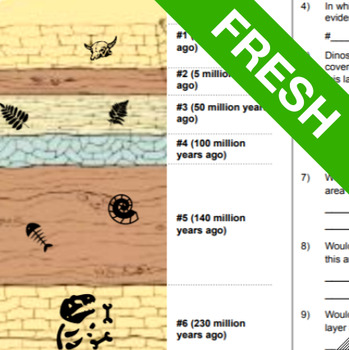Hiikoo Learning
47 Followers
Grade Levels
3rd - 6th
Subjects
Resource Type
Standards
NGSSMS-ESS1-4
NGSS4-ESS1-1
NGSS3-LS4-1
NGSSMS-LS4-1
Formats Included
- PDF
- Easel Activity
Pages
1 page
FREE
Hiikoo Learning
47 Followers
Easel Activity Included
This resource includes a ready-to-use interactive activity students can complete on any device. Easel by TPT is free to use! Learn more.
Also included in
- This huge bundle of activities offers a wide array of ways to get kids excited about Fossils and Rock Layers (4-ESS1-1). With hours and hours of content to keep kids busy and engaged with standards-aligned activities, your kids will love the variety of experiences in this bundle.Price $11.99Original Price $16.85Save $4.86
- This bundle of NGSS standards-aligned activities will help students better understand 4th grade earth science concepts through video lessons, worksheets, printable activities, coloring pages, ELA + Science extensions, and more!Price $15.99Original Price $28.63Save $12.64
- Three awesome activities where students will analyze fossils and rock layers, then explain what they can tell us about the history of the Earth. Designed to help students analyze the types of diagrams they will see on Standardized Testing. No-prep needed.Price $4.99Original Price $5.98Save $0.99
Description
Students will analyze fossils in rock layers and draw conclusions. No-prep needed.
Total Pages
1 page
Answer Key
N/A
Teaching Duration
N/A
Report this resource to TPT
Reported resources will be reviewed by our team. Report this resource to let us know if this resource violates TPT’s content guidelines.
Standards
to see state-specific standards (only available in the US).
NGSSMS-ESS1-4
Construct a scientific explanation based on evidence from rock strata for how the geologic time scale is used to organize Earth’s 4.6-billion-year-old history. Emphasis is on how analyses of rock formations and the fossils they contain are used to establish relative ages of major events in Earth’s history. Examples of Earth’s major events could range from being very recent (such as the last Ice Age or the earliest fossils of homo sapiens) to very old (such as the formation of Earth or the earliest evidence of life). Examples can include the formation of mountain chains and ocean basins, the evolution or extinction of particular living organisms, or significant volcanic eruptions. Assessment does not include recalling the names of specific periods or epochs and events within them.
NGSS4-ESS1-1
Identify evidence from patterns in rock formations and fossils in rock layers to support an explanation for changes in a landscape over time. Examples of evidence from patterns could include rock layers with marine shell fossils above rock layers with plant fossils and no shells, indicating a change from land to water over time; and, a canyon with different rock layers in the walls and a river in the bottom, indicating that over time a river cut through the rock. Assessment does not include specific knowledge of the mechanism of rock formation or memorization of specific rock formations and layers. Assessment is limited to relative time.
NGSS3-LS4-1
Analyze and interpret data from fossils to provide evidence of the organisms and the environments in which they lived long ago. Examples of data could include type, size, and distributions of fossil organisms. Examples of fossils and environments could include marine fossils found on dry land, tropical plant fossils found in Arctic areas, and fossils of extinct organisms. Assessment does not include identification of specific fossils or present plants and animals. Assessment is limited to major fossil types and relative ages.
NGSSMS-LS4-1
Analyze and interpret data for patterns in the fossil record that document the existence, diversity, extinction, and change of life forms throughout the history of life on Earth under the assumption that natural laws operate today as in the past. Emphasis is on finding patterns of changes in the level of complexity of anatomical structures in organisms and the chronological order of fossil appearance in the rock layers. Assessment does not include the names of individual species or geological eras in the fossil record.






